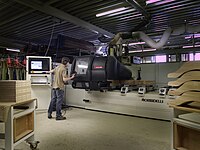
Photo from wikipedia
Surface functionalization of cellulose nanocrystals (CNCs) is valuable option to tailor properties as well as increase opportunities for their application. In this study, the surface of CNCs was functionalized with… Click to show full abstract
Surface functionalization of cellulose nanocrystals (CNCs) is valuable option to tailor properties as well as increase opportunities for their application. In this study, the surface of CNCs was functionalized with 3-aminopropyltriethoxysilane (APTES), without using hazardous solvents and by a direct, simple and straightforward method. APTES was firstly hydrolyzed in water and then adsorbed onto CNC through hydrogen bonds, finally the chain hydrocarbon was covalently linked to the surface of CNC through SiOC bonds which formed via the condensation reaction between hydroxyl and silanol groups. The chemical modification of the CNCs surface was confirmed by ATR-IR and NMR spectroscopy. Experiments conducted by AFM and XRD showed no significant change in the CNC dimensions and crystalline structure as a result of the modification. The EDX and XPS results confirmed the exsistence of APTES onto the CNCs. Silylated CNC exhibited good thermal stability and a greater amount of residual char was formed at 500 °C compared to non-chemically modified CNC. Thus, The silylation of CNCs may offer applications in composite manufacturing, where these nanoparticles have limited dispersibility in hydrophobic polymer matrices, and as nano-adsorbers due to the presence of amino groups attached on the surface.
Journal Title: International journal of biological macromolecules
Year Published: 2018
Link to full text (if available)
Share on Social Media: Sign Up to like & get
recommendations!